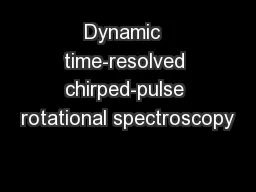

in a room temperature flow reactor Daniel zaleski lawrence Harding stephen klippenstein branko ruscic Kirill prozument Argonne National Laboratory Chemical Sciences amp Engineering Division ID: 632190
Download Presentation The PPT/PDF document "Dynamic time-resolved chirped-pulse rot..." is the property of its rightful owner. Permission is granted to download and print the materials on this web site for personal, non-commercial use only, and to display it on your personal computer provided you do not modify the materials and that you retain all copyright notices contained in the materials. By downloading content from our website, you accept the terms of this agreement.
Slide1
Dynamic time-resolved chirped-pulse rotational spectroscopy in a room temperature flow reactor
Daniel zaleski, lawrence Harding, stephen klippenstein, branko ruscic, Kirill prozument
Argonne National LaboratoryChemical Sciences & Engineering Division
72nd International Symposium on Molecular Spectroscopy21 June, 2017Urbana-Champaign, IllinoisSlide2
chemical dynamics and kinetics studiesImplementing a deductive scientific approach: first-principles predictions of the behavior of complex chemical systemsMulti-species quantitative spectroscopy is how we will test these predictive kinetic modelsDiscrepancies between experiments and kinetics models will arise, and some of them will direct extension or revision of the dynamical
mechanismsTime-resolved, quantum state- and isomer- specific quantitative and multi-species spectroscopy is now we will test dynamic mechanisms1. Dynamic Time-Resolved Chirped-Pulse (DTRCP) Spectroscopy2. Reactor with well-characterized T and P conditions of the “bath”2Slide3
58–92 GHz operating frequency range23 GHz instantaneous bandwidthTunable downconversion local oscillator35 h phase stabilityArgonne dynamic time-resolved chirped
-pulse (DTRCP) spectrometer3D. P. Zaleski, K. Prozument, Chem. Phys. Lett., 680 (2017) 101–108Slide4
4Flow tube reactor/cp spectrometerSlide5
5193 nm photolysis of vinyl cyanide (CH2CHCN)
Focus on HCN, HNC and HCCCN photo-productsSlide6
6Dynamic Time-resolved cp spectroscopy
Argonne/BrightSpec DTRCP SpectrometerFine time resolution (10 μs)Multiple transitionsLong post-photolysis observation times (0.5 s)Slide7
7Dynamic Time-resolved cp spectroscopy
Argonne/BrightSpec DTRCP SpectrometerFine time resolution (10 μs)Rotational thermalization of hot nascent photoproducts (0 – 1 ms)Evacuation of photoproducts from the cell (5 – 500 ms)Products branching ratios at 1 – 5 msHNC HCN isomerizationWall effectsP (CH2CHCN) = 1 µbar (0.76 mTorr)P (argon) = 9 µbar (6.8 mTorr)Slide8
8Dynamic Time-resolved cp spectroscopySynchronized HDR mode of W–band BrightSpec CP-FTmmW Spectrometer
Medium time-resolution (0.1 – 1000 ms)High duty cycleVibrational population distributionsSlide9
9Dynamic Time-resolved cp
spectroscopyt : 1 – 5 msHCCCN VPD: 0 – 400 µsHCCCN VPD: 1 – 5 msSynchronized HDR mode of W–band BrightSpec CP-FTmmW SpectrometerMedium time-resolution (0.1 – 1000 ms)High duty cycleVibrational population distributionsSlide10
10Hcn/hcccn Branching ratio
SpeciesCH2CHCNCH2CHCN*HCNHCCCNn, cm-3
2.46 × 10131.72 × 10123.52 × 10112.15 × 1011N1.74 × 10161.22 × 10152.49 × 10141.52 × 1014Slide11
11Remaining reaction channels
TSH: CH2CHCN CH2CCN + HCH2CCN HCCCN + H Main dissociation channel TSHCyanovinyl radical not observed (need more sensitivity) Slide12
Thanks12Prof. Brooks Pate, UVA
Prof. Robert W Field, MITProf. Arthur Suits, Missouri Dr. Alexander Heifetz, ArgonneSlide13
13conclusions and outlookImplemented time-resolved broadband rotational spectroscopy at room temperature
A better-characterized flow tube reactor at 295 KPressure can be varied by a factor between 1 and 100 µbarA 260–290 GHz spectrometer will increase sensitivityRotational and vibrational collisional relaxation effects observedProducts branching ratios measured and compared with theoryThe approach is suitable for studying reaction pathways branchings, non-thermal kinetic effectsSlide14
thank you!